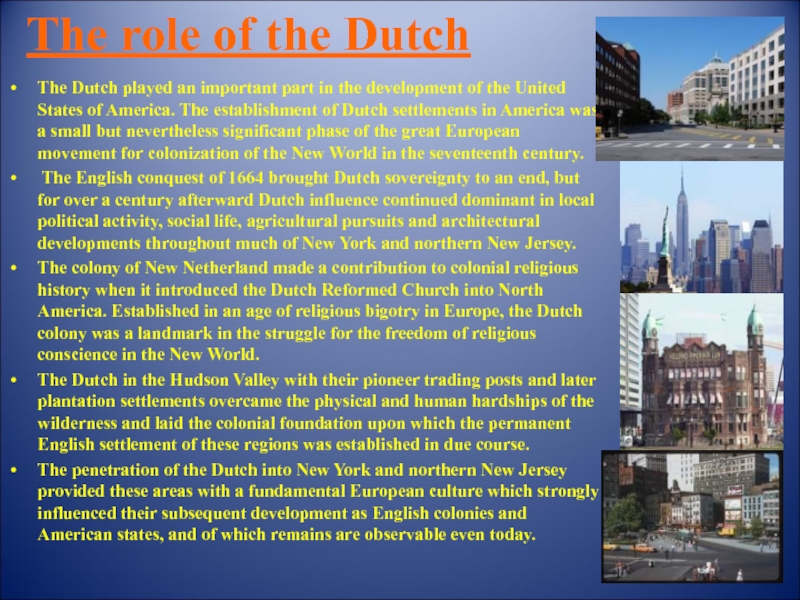Слайд 1Dutch influence on North America
Курс страноведения
Духовская М. Б.
МБОУ СОШ № 6 г. Павлово
Слайд 2How the Dutch opened North America
In
1602, Dutch government chartered the Dutch East India Company ("Verenigde
Oostindische Compagnie", VOC) with the mission of exploring a passage to the Indies and claiming any unchartered territories for the Dutch Republic.
The first Dutchmen to come to America were explorers under the command of the English captain Henry Hudson, an English navigator. Like explorers before him, Hudson traveled west on the Half Moon looking for the Northwest Passage through North America to achieve his goal. On September 10, he sailed up the river that now bears his name to Albany. The desired passage was not found, but Hudson's discovery laid claim to lands in North America for the founding of New Netherland. Dutch trading posts were established in the fertile valley and the region was loosely knit into a province by a natural highway which provided communication and transportation for merchandise. The Dutch settlement progressed slowly thereafter.
Слайд 3Dutch colonial flag
The Dutch East Indies Company
used versions of the company flag. The tricolored flag used
the Dutch national colors and had a large "V" and smaller "O" and "C" standing for the "Vereenigde Oostindische Compagnie" or United East India Company. It was called "united" because it was actually six local companies, each based in a different Dutch city (Amsterdam, Delft, Enkhuizen, Hoorn, Middleburgh, and Rotterdam). Other modern variants of this flag (and there are many) show the "V" reversed as an "A" standing for "Algemeene Oostindische Compagnie" or General East India Company. Some claim the "A" stood for "Amsterdam," but although various chambers had their own local flags for the company, the city initials in reality never replaced the "V."
Слайд 4New Netherland
Nieuw-Nederland, or New Netherland, was the 17th century Dutch
colonial province on the eastern coast of North America. The
earliest Dutch settlement was built around 1613, it consisted of a number of small huts built by the crew of the "Tijger" ("Tiger") a Dutch ship under the command of Captain Adriaen Block which had caught fire while sailing on the Hudson in the winter of 1613. The ship was lost and Block and his crew established a camp ashore. In the spring Block and his men did some explorations along the coast of Long Island. Block Island still bears his name. Finally they were sighted by another Dutch ship and the settlement was abandoned.
The claimed territory were the lands from the Delmarva Peninsula to Buzzards Bay, while the settled areas are now part of New Jersey, New York, Connecticut, Delaware, and Pennsylvania. Its capital, New Amsterdam, was located at the southern tip of the island of Manhattan on the Upper New York Bay and was renamed New York. The peak population was less than 10,000.
The English took complete control of the colony in 1674. However the Dutch landholdings remained, and the Hudson River Valley maintained a traditional Dutch character down to the 1820s.
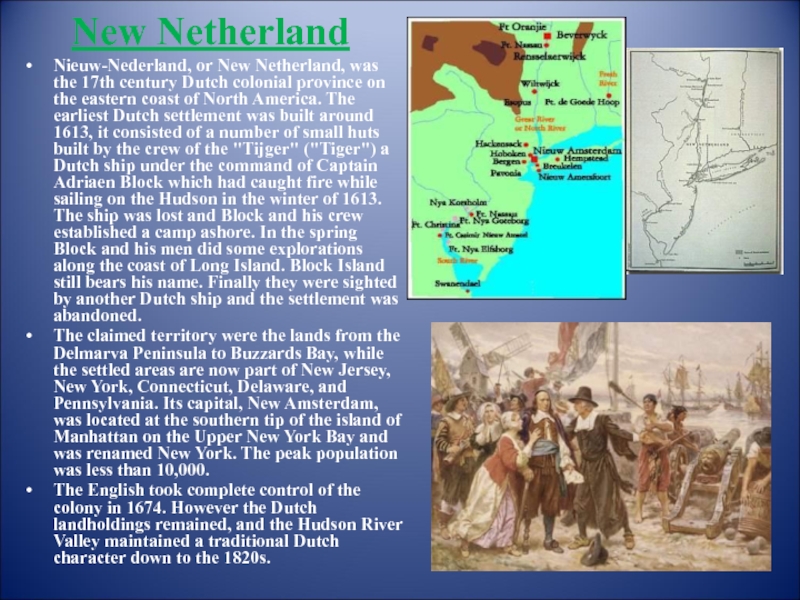
Слайд 5New Amsterdam
European settlement began with the founding of a Dutch
fur trading settlement, later called "Nieuw Amsterdam" (New Amsterdam), on
the southern tip of Manhattan in 1614. Dutch colonial Director-General Peter Minuit purchased the island of Manhattan from the Lenape in 1626 for a value of 60 guilders (about $1000 in 2006). Peter Minuit became Director of the New Netherland in 1626 and made a decision that would greatly affect the new colony. Originally, the capital of the province was to be located on the South River, but it was soon realized that the location was susceptible to mosquito infestation in the summer and the freezing of its waterways in the winter. He chose instead the island of Manhattan at the mouth of the river explored by Hudson, at that time called the North River. Minuit traded some goods with the local population and reported that he had purchased it from the natives, as was company policy. He ordered the construction of Fort Amsterdam at its southern tip, around which would grow the heart of the province.
In September 1664 an attack financed by England's Duke of York forced the capitulation of New Netherland. The invasion was the opening round in the Second Anglo-Dutch War (1664–1666). At war's end a grateful Charles II bequeathed “New York” to his brother, the Duke. New Amsterdam became New York City.
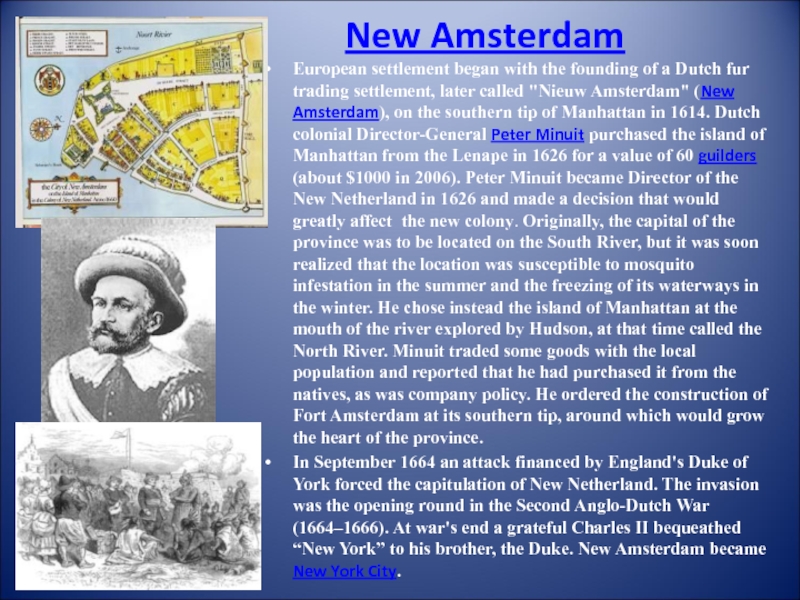
Слайд 6Life in New Amsterdam
Earliest life in New Amsterdam was
primitive by today's standards. There were about thirty houses on
the east side of the river. A horse mill with a large room above used as a meeting place for religious services. Each colonist had his own farm on the Company's land and was supplied with cows. By 1628, Fort Amsterdam was completed with four bastions, and faced with stone. There were now 270 people in the colony including men, women and children and the people supported themselves chiefly by farming. While the Dutch were known for extreme cleanliness, this did not apply to the streets.
People would throw their rubbish, filth, dead animals and such into the public streets.
Gardens were very important in New Netherland and sometimes men whose sole occupation was gardening, were the keepers of the gardens. Fruit and vegetable sellers displayed their wares in baskets in their shops and also carried them from door to door, even on Sundays.
At a later period the Rattle Watch was instituted, consisting of six men whose duty was to patrol streets at night, to arrest thieves, to give alarm in case of fire, and all other warnings. They carried a large rattle. Each man received eighteen guilders a month.
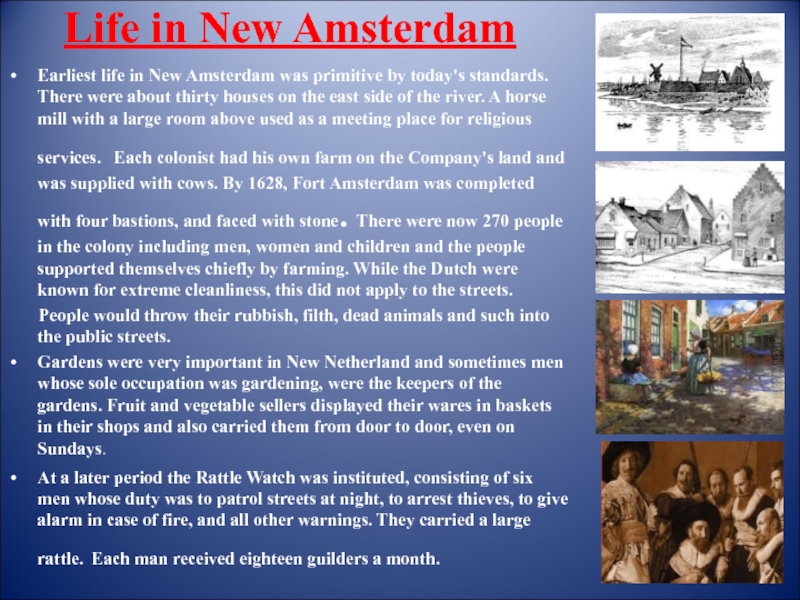
Слайд 7Eighteenth and nineteenth-century migration
In the hundred years of British
rule that followed the change of ownership of New Netherland,
Dutch immigration to America came to an almost complete standstill. The only major group of organized settlers after the British takeover were a colony of two hundred Dutchmen and women who founded what is now Germantown in 1683.
Most of these settlers were Quakers who had come over in response to the appeal of William Penn. Penn, a Dutch American himself, had paid three visits to the Netherlands, where he published several pamphlets. Germantown is now generally thought to be of German origin, but it remained almost exclusively Dutch until the beginning of the eighteenth century.
During the early nineteenth century, large numbers of Dutch farmers, forced by high taxes and low wages, started immigrating to America. They mainly settled down in the Midwest, especially Michigan, Illinois and Iowa.
Слайд 8The Reformed Church in America
The beginnings
of the Reformed Church in America date to 1628. Until
the English conquest of New Netherland in 1664, the Reformed Church was the established church of the colony. After that, while still owing ecclesiastical allegiance to the church of Amsterdam in Holland, it gave civil allegiance to England. However, the church continued to expand.
By 1740, it had 65 congregations in New York and New Jersey, served by ministers trained in Europe. In 1771, there were 34 ministers for over 100 churches. Until 1764, in at least three Dutch churches in New York City, all sermons were in Dutch; Other churches with roots in Dutch immigration include the Christian Reformed Church, the Protestant Reformed Churches, the United Reformed Churches, the Netherlands Reformed Congregations, the Heritage Netherlands Reformed Congregations and the Free Reformed Church. Along with the Reformed churches, Roman Catholicism is the other major religion of Dutch Americans.
Слайд 9Free Blacks and Slaves In Dutch Manhattan
The early history of
black life in New York City includes slaves, servants and
free men, and dates back to the earliest days of the Dutch settlement of New Amsterdam.
In 1625, a small group of persecuted Walloons settled on the green island that the Lenape Indians called Mannahatta, or Island of Many Hills. The following year, eleven African slaves, owned by the Dutch West India Company, joined them.
By the 1640s, New Amsterdam was home to black and Native American slaves, free blacks, and black and white indentured servants. Slavery under the Dutch was very different than it was under the British or in the post revolutionary United States. Free blacks had the uncontested legal right to own property; that ownership was, according to Peter Stuyvesant, “true and free.” In 1647 a group of settlers who had gathered to await Stuyvesant’s return from Europe, were white people, slaves and free blacks, including Anna von Angola, an African widow who had recently been granted ownership of a farm on Manhattan. In 1663, as they prepared to cede ownership of New Amsterdam to the British, the Dutch granted complete freedom to all half-free blacks. When the British came the following year, Manhattan's black population included approximately three hundred slaves and 75 free blacks, thirty of whom were landowners.
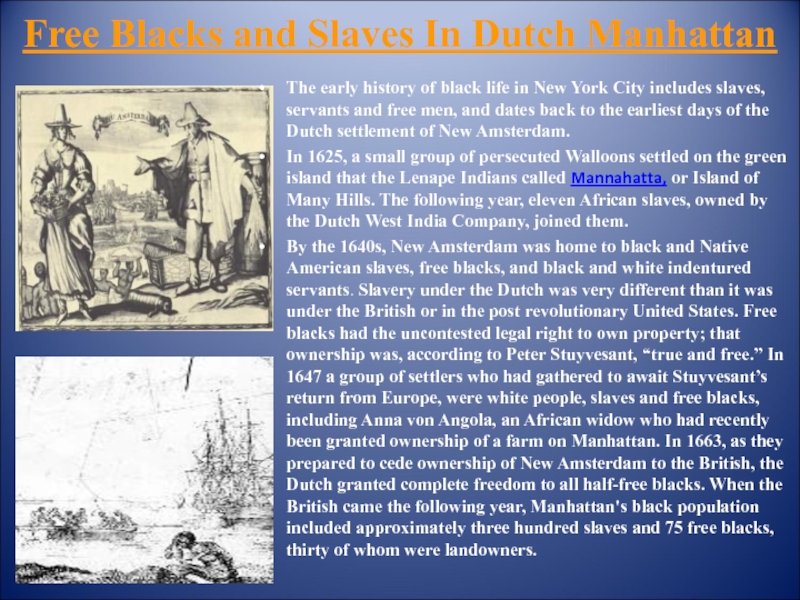
Слайд 10The Original Silver Dollar
The Leeuwen-daalder used in the early
north-east American colonies was commonly known as the "Dog" or
Lion Dollar. Minted in Holland to facilitate foreign trade in the 17th Century it was the origin of the silver Dollar.
The Dutch, originally settled in New Netherlands colony (New York), used the Dutch silver dollar, also named it a “dog dollar” because the picture of a “Lyon” (lion) resembled a dog on its face. Obverse : An armored knight is looking to right with plume on the helmet. A shield is bearing a lion in front of his legs. Within two circles around the rim there is a version of the legend, MO. ARG. PRO. CONFOE. BELG. TRAN . This abbreviated Latin legend may be transcribed as: MONETA ARGENTEA PROVINCIARUM CONFOEDERATUM BELGICARUM TRANSISULANIA which translates as "Coin Silver of the Province of the Confederation Belgium - Transisulania" (Overijssel). Reverse : A Rampant lion is facing left in center. Within two circles around the rim there is the year of issue 1616 on the top and along periphery the Latin legend CONFIDENS.DNO.NON.MOVETVR expands to CONFIDENS DOMINO NON MOVETVR which translates as "Confidence in the Lord is not moved“.

Слайд 11Dutch Ceramics and Silver of the 18th Century
The Dutch colonists
who settled the rural areas of Pennsylvania and New York
in the late 17th century were heirs not only to the cooking and eating traditions of their homelands in Northern Europe, but to the cooking technologies as well.
By the 1680s and 1690s, colonial silversmiths had been commissioned to fashion such items as spoons, tankards, beakers, and two-handled cups for domestic use and display.
The Ritz Collection of Food Technology includes about fifty pieces of household ceramic and silver containers used in preparing and storing food that reflect the traditions of the Dutch food ways continued in North America. Produced mainly in the 18th century for common domestic purposes such as dairying and cheese production, these objects clearly reflect the influence of Northern European ceramic traditions.
Dutch heritage is evident in the craft practices of the housewrights, furniture makers, and silversmiths as well as in the products of their workshops
Слайд 12Dutch Colonial Style Home
The Dutch Colonial Style Home distinction is
Gambrel Roof.
This design was first built in the New
Amsterdam area, which is what we now call New York, and has later migrated throughout the country. This type of roof allows more room on the second floor as well as an additional loft, or attic space.
Originally designed for economical purposes, this style has become one of today's more costly roofs to build. Like a typical colonial, the front door is centered on the facade of the home. There are an equal number of windows on either side of the door and on any additional floors. This style remains nowadays.
Dutch colonial homes are easy to identify. These homes have a barn-like appearance and are often made from brick, stone or both. The front door is centered on the facade of the home. In addition, these homes often had double hung sash windows, a gamble roof and a Dutch double doorway. The Dutch double doorway was a door that was split horizontally across the middle of the door. This allowed for the top half of the door to be open and let in a cool breeze while the bottom half kept children in.
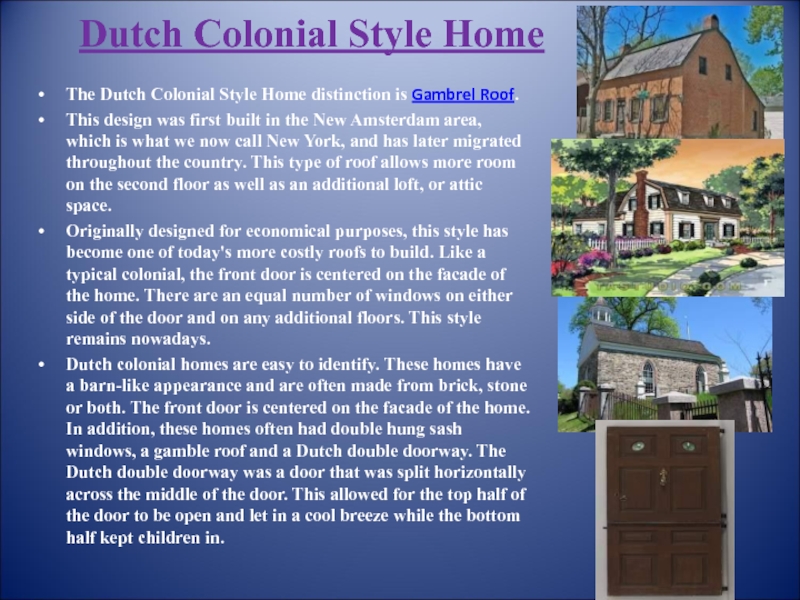
Слайд 13Dutch language in North America
When the Dutch colonized New Netherland, now known as the
Hudson Valley and Long Island in the State of New York, they naturally introduced their language. The Dutch colonial settlers followed their own language, customs and religion, and were numerically strong enough to influence those around them. They published books and newspapers. the Dutch language continued to be widely spoken in the New York region for over 200 years.
In the first half of the twentieth century, books and newspapers in the Dutch language were hardly spoken in North America, with the exception of the 1st generation of Dutch immigrants. But the marks of the Dutch language can still be seen. New York for example has many originally Dutch streets and place names which range from Coney Island and Brooklyn to Wall Street and Broadway. There are also some words in American-English that are of Dutch origin, like "cookie" (koekje) and "boss" (baas), brandy, coleslaw, cruller, dope, sled, sledge, sleigh, stoop, Yankee ,dam, delft, Dutch, Flemish, foist, gin , groove, kermis, measles, Santa Claus, waffle.

Слайд 14Yankees
The term Yankee (sometimes shortened to Yank) has several interrelated
meanings, usually referring to people originating in the northeastern United
States. The linguists consider the word had the Dutch origin.
Some of them think, the Dutch names Jan and Kees were and still are common, and sometimes are combined into a single name, Jan-Kees. The word Yankee could have referred to English settlers moving into previously Dutch areas.
The others come to the conclusion, that the term refers to the Dutch nickname and surname Janneke (from Jan and the diminutive -eke, meaning "Little John" or Johnny in Dutch), it was anglicized to Yankee (in Dutch, the letter "J" is pronounced the same way as the English consonantal "Y" sound) and used as a nickname for a Dutch-speaking Americans in colonial times. By extension, the term could have grown to include non-Dutch colonists as well.
Слайд 15Knickerbockers
The word «Knickerbocker» is very popular in New York.
The name
"Knickerbocker" first acquired meaning with Washington Irving's History of New
York, which featured the fictional author Diedrich Knickerbocker, an old-fashioned Dutch New Yorker. After Irving's History, by 1831, "Knickerbocker" had become a local byword for an imagined old Dutch-descended New York aristocracy and a nickname of
New York itself. Knickerbockers are men's or boys' breeches or baggy-kneed trousers particularly popular in the early twentieth century in the USA.
the "New York Knickerbockers" were an amateur social and athletic club organized by Alexander Cartwright on Manhattan's (Lower) East Side in 1842, largely to play "base ball" according to written rules, it was the first organized team in baseball history;
"Knickerbocker Beer“ is beer locally-brewed by Jacob Ruppert, one of the first sponsors of the TV shows !
Слайд 16Dutch Influence on New York Streets and Place Names
The Dutch
presence can be seen in many streets and place names.
Take Amsterdam Avenue, for example, Wall Street and Broadway or Stuyvesant Park between East 15th and East 17th Streets in Manhattan, named after Peter Stuyvesant, the last director-general of the Dutch colony of New Netherland.
Some names, like Harlem of course, Newkirk or Brooklyn, have had their spellings altered, but their Dutch origin is still apparent. Other names, such as Gansevoort Street and Hoyt-Schermerhorn Street, have kept their spellings intact, although these days they are not pronounced with the Dutch guttural back-of-the-throat sound; then the delightful Spuyton-Duyvil. The Bronx only has the Dutch pronunciation.
Like many cities, names in New York reflect its history. Despite the Dutch having ceded control of New York over 340 years ago, reminders of their short time there are scattered all over the city up to this day.
The influence of the Dutch is still evident in the name of one of the USA's states. Rhode Island comes from the Dutch description of the states red clay. In New York state you will see Dutch place names such as Piermont, Orangeburg, Blauvelt and Haverstraw.

Слайд 17Wall Street
Wall Street refers to the financial district of New
York City and centered on the eight-block-long street running from
Broadway to South Street on the East River in lower Manhattan. Now it is one of the most important financial centres of the world.
There are different opinions about how the Dutch-named "de Waal Straat" got its name. A generally accepted version is that the name of the street was derived from a wall on the northern boundary of the New Amsterdam settlement, perhaps to protect against English colonial encroachment or incursions by native Americans. A conflicting explanation is that Wall Street was named after Walloons -- possibly a Dutch abbreviation for Walloon -Waal. Among the first settlers that embarked on the ship "Nieu Nederlandt" in 1624 were 30 Walloon families (French speaking Protestant refugees from the southern Netherlands).
Слайд 18Brooklyn
Brooklyn is the most populous of New York City's five
boroughs, with nearly 2.6 million residents, and the second-largest area.
Since 1896, Brooklyn has had the same boundaries as Kings County, which is now the most populous county in New York State and the second-most densely populated county in the United States, after New York County (Manhattan). It is also the westernmost county on Long Island.
The Village of Breuckelen, named for Breukelen in the province of Utrecht in the Netherlands, was authorized by the Dutch West India Company in 1646; it became the first municipality in what is now New York State. At the time, Breuckelen was part of New Netherland. Other villages which were later incorporated into Brooklyn were Boswijk (Bushwick), Nieuw Utrecht (New Utrecht), and Nieuw Amersfoort (Flatlands). A few houses and cemeteries still bear witness to the Dutch origins of the borough of Brooklyn.
Слайд 19Harlem
Harlem is a neighborhood in the New York City borough
of Manhattan, which since the 1920s has been a major
African-American residential, cultural, and business center. Originally a Dutch village, formally organized in 1658, it is named after the city of Haarlem in the Netherlands. Harlem was annexed to New York City in 1873.
The first European settlement in the area was founded by Hendrick (Henry) de Forest, Isaac de Forest, his brother, and their sister Rachel de Forest, French – Dutch immigrants in 1637.
The settlement was formalized in 1658 as Nieuw Haarlem (New Haarlem), under leadership of Peter Stuyvesant, and was formally incorporated in 1660.
The Indian trail to Harlem's lush bottomland meadows was rebuilt by black laborers of the Dutch West India Company, and eventually developed into the Boston Post Road. In 1664, the English took control of the New Netherland colony and tried to change the name of the community to "Lancaster," but the name never stuck, and eventually settled down to the anglicized Harlem.
Слайд 20Courtship and Marriage Customs
Courtship customs in Dutch colonies varied, depending
upon the origin of the couple. North Holland customs allowed
a daughter much more latitude than South Holland customs, for example. Parents from North Holland could be absent when the "suitor" visited the daughter and allowed the couple a separate room for courtship. Parents from South Holland, on the other hand, strictly watched their daughters.
If upon a first visit the girl stood up, arranged her bonnet, and smoothed out her dress so as to make herself attractive, the suitor knew he was welcome, but if she went to the fireplace and gripped the tongs, he knew he wasn't!
Records show that the betrothal was very binding in the eyes of the law. A promise of marriage also involved the exchange of a pledge, usually in the form of a ring or a coin. If the engagement were broken after the publication of the banns, the punishment could be severe.
The Dutch of New York and New Jersey conducted wedding ceremonies in their native language and followed up the civil ceremony with a celebration. Open house was kept on the wedding day in New Amsterdam. There was much food, merrymaking and consumption of liquor - an often considerable amount.
These customs have interesting similarities with the present day customs in much of America.

Слайд 21Dutch colonial New Year's Celebrations
The Dutch colonists had their
own customs and traditions. For example:
The celebration of New Year
appeared in America in the 17th century because of Dutch colonists who brought the custom to the continent.
Dutch immigrants in the Hudson River valley welcomed the New Year by "opening the house" to family and friends. The custom was adapted by English colonists. Ladies remained at home, offering elegantly arrayed collations laden with cherry bounce, wine, hot punch, and cakes and cookies, often flavored with the Dutch signatures of caraway, coriander, cardamom, and honey.
New Year's Eve was especially noisy, with the firing of guns to bring in New Year. Ordinances in both the Netherlands and New Netherland eventually prohibited such behavior.
The special treat for New Year's Day in the Netherlands was nieuwjaarskoeken. The American New Year's cake is a combination of two Dutch pastries brought here by the early settlers.
Слайд 22Sinterklaas
The Dutch introduced their own folklore, most famously "Sinterklaas" (Similar
to, but not the same as, "Santa Claus)
Sinterklaas , is
a traditional Winter holiday figure in Dutch-speaking Europe. Sinterklaas is an elderly, stately and serious man with white hair and a long, full beard. He wears a long red cape or chasuble over a traditional white bishop's alb, dons a red mitre, and holds a gold-colored crosier, a long ceremonial shepherd's staff with a fancy curled top. Sinterklaas is the basis for the North American figure of Santa Claus. It is often claimed that during the American War of Independence the inhabitants of New York City, a former Dutch colonial town (New Amsterdam) reinvented their Sinterklaas tradition, as Saint Nicholas was a symbol of the city's non-English past. The Saint Nicholas Society of New York celebrates a feast on the 6th of December to this day. It includes Sinterklaas' crossing the Hudson River and a parade up to the center of the town.
Traditionally, in the weeks between his arrival and the 5th of December, before going to bed, children put their shoes next to the fireplace chimney of the coal-fired stove or fireplace. In modern times, they may put them next to the central heating unit. They leave the shoe with a carrot or some hay in it and a bowl of water nearby "for Sinterklaas' horse", and the children sing a Sinterklaas song. The next day they will find some candy or a small present in their shoes.

Слайд 23Dutch Heritage Festivals
Many of the Dutch heritage festivals that take
place around the United States coincide with flowers.
The Tulip Festivals
are held in several North American cities, including Albany, New YorkThe Tulip Festivals are held in several North American cities, including Albany, New York; OttawaThe Tulip Festivals are held in several North American cities, including Albany, New York; Ottawa, OntarioThe Tulip Festivals are held in several North American cities, including Albany, New York; Ottawa, Ontario; GatineauThe Tulip Festivals are held in several North American cities, including Albany, New York; Ottawa, Ontario; Gatineau, QuebecThe Tulip Festivals are held in several North American cities, including Albany, New York; Ottawa, Ontario; Gatineau, Quebec ; MontrealThe Tulip Festivals are held in several North American cities, including Albany, New York; Ottawa, Ontario; Gatineau, Quebec ; Montreal, QuebecThe Tulip Festivals are held in several North American cities, including Albany, New York; Ottawa, Ontario; Gatineau, Quebec ; Montreal, Quebec; Holland, MichiganThe Tulip Festivals are held in several North American cities, including Albany, New York; Ottawa, Ontario; Gatineau, Quebec ; Montreal, Quebec; Holland, Michigan; Lehi, UtahThe Tulip Festivals are held in several North American cities, including Albany, New York; Ottawa, Ontario; Gatineau, Quebec ; Montreal, Quebec; Holland, Michigan; Lehi, Utah; Orange City, IowaThe Tulip Festivals are held in several North American cities, including Albany, New York; Ottawa, Ontario; Gatineau, Quebec ; Montreal, Quebec; Holland, Michigan; Lehi, Utah; Orange City, Iowa; Pella, IowaThe Tulip Festivals are held in several North American cities, including Albany, New York; Ottawa, Ontario; Gatineau, Quebec ; Montreal, Quebec; Holland, Michigan; Lehi, Utah; Orange City, Iowa; Pella, Iowa; Mount Vernon, WashingtonThe Tulip Festivals are held in several North American cities, including Albany, New York; Ottawa, Ontario; Gatineau, Quebec ; Montreal, Quebec; Holland, Michigan; Lehi, Utah; Orange City, Iowa; Pella, Iowa; Mount Vernon, Washington; and Woodburn, OregonThe Tulip Festivals are held in several North American cities, including Albany, New York; Ottawa, Ontario; Gatineau, Quebec ; Montreal, Quebec; Holland, Michigan; Lehi, Utah; Orange City, Iowa; Pella, Iowa; Mount Vernon, Washington; and Woodburn, Oregon. The tulips are considered a welcome harbinger of spring, and a tulip festival permits residents to see them at their best advantage. The festivals are also popular tourist attractions. The tulips are displayed throughout the cities.
Pinkster is a spring festival, taking place in late May or early June. The name is a variation of the Dutch word Pinksteren, meaning "Pentecost". To the Dutch, Pinkster was a religious holiday, a chance to rest, gather, and celebrate religious services like baptisms and confirmations. For their African slaves, Pinkster was a time free from work and a chance to gather and catch up with family and friends.
Pinkster is a spring festival, taking
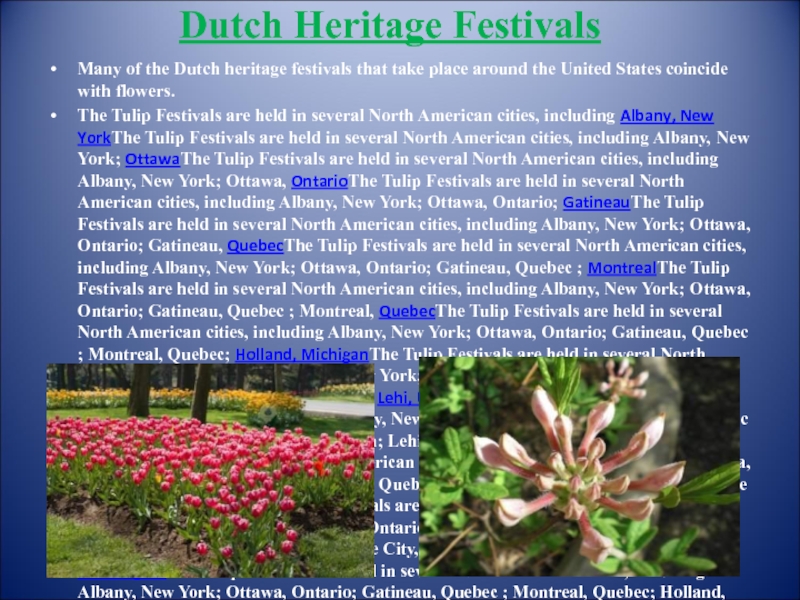
Слайд 24Dutch-American Holidays
November 16th is a "Dutch-American Heritage Day". On November
16, 1776, a small American warship, the Andrew Doria, sailed
into the harbour of the Dutch island of St. Eustatius in the West Indies. Only four months before, the United States had declared its independence from Great Britain. The American crew was delighted when the governor of the island, ordered that his fort's cannons be fired in a friendly salute. The first ever given by a foreign power to the flag of the United States, it was a risky and courageous act. Indeed, angered by Dutch trading and contraband with the rebellious colonies, the British seized the island a few years later. The Dutch recaptured the island in 1784.
April 19th is а Dutch-American Friendship Day, which remembers the day in 1782 when John Adams, the second president of the United States, was received by the States General in The Hague and recognized as Minister Plenipotentiary of the United States of America. It was also the day that the house he had purchased at Fluwelen Burgwal 18 in The Hague was to become the first American Embassy in the world.
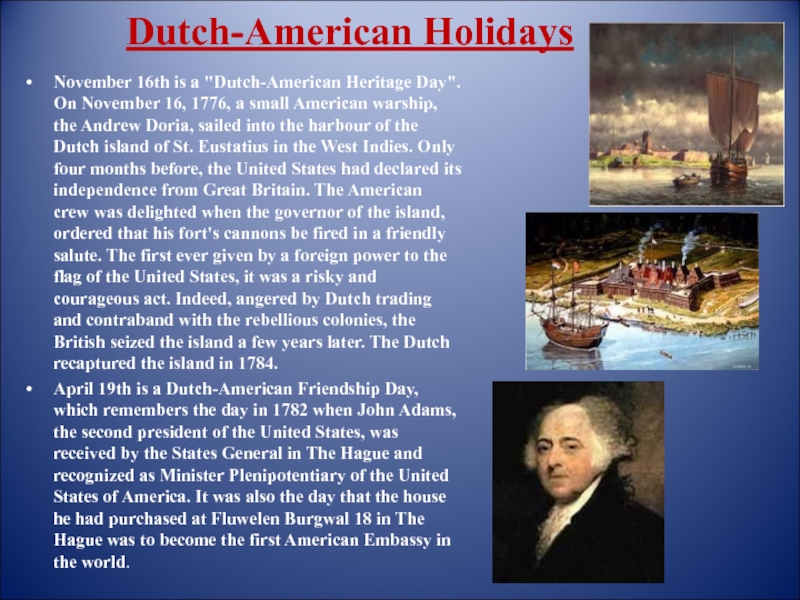
Слайд 25About early New Netherland foodways
The Dutch loved cakes, pastries, and
breads. Dumplings, pancakes, and waffles, which the Dutch introduced to
American cuisine, figured prominently in their daily menus. Settlers brought long-handled waffle irons from Holland and used them in the fireplaces of their colonial homes. The Dutch quickly adopted Indian corn, which they called "Turkey wheat," and made it into a porridge. The Dutch learned how to cook some Indian dishes and fit them into their daily fare. For lovers of porridge it was not hard; and the pumpkin easily fitted into a common Dutch meal as pumpkin pancakes. Roast duck with dumplings, pork with cabbage, or roast goose were served on holidays. For dessert, oliekocken were often served. These pastries, made with a raised yeast dough, shaped into small balls, and fried in hot lard until golden brown, were named "doughnuts". Tea, sugar, spices, chocolate, wines and brandies were all readily available in the Dutch colony.
The Dutch started the first public bakeries in America in 1656.
Слайд 26Peter Stuyvesant, 1646-1664
The last Director-General of New
Netherland was the somewhat notorious Peter Stuyvesant, а former soldier.
Peter Stuyvesant arrived in New Amsterdam in 1647, the only governor of the colony to be called Director-General. The injury left him with the unfortunate nicknames of "Peg Leg Pete" and "Old Silver Nails" from the stick of wood studded with silver nails that was his artificial limb. The Dutch West India Company appointed Stuyvesant at a time when the colony was most vulnerable to failure. During the period of his governorship the province experienced exponential growth. The English took complete control of the colony in 1674. Many Dutch settlers, as well as Stuyvesant, remained in America and accepted English rule and law that included the promise of town government. Peter Stuyvesant retired to his farm on Manhattan Island and is buried on the grounds of St. Mark’s Episcopal Church on the Bowery.
Слайд 27Adriaen van der Donck
Adriaen Cornelissen van der Donck (ca. 1618
– ca. 1655) was a lawyer and landowner in New
Netherland. In addition to being the first lawyer in the Dutch colony, he was a leader in the political life of New Amsterdam (modern New York City), and an activist for Dutch-style republican government in the Dutch West India Company. He gave America its first written declaration against tyranny.
Enchanted by his new homeland of New Netherland, Van der Donck made detailed accounts of the land, vegetation, animals, waterways, topography, and climate. Van der Donck used this knowledge to actively promote immigration to the colony, publishing several tracts, including his influential «Description of New Netherland.» It was an essential first-hand account of the lives and world of Dutch colonists and northeastern Native communities in the seventeenth century. Adriaen van der Donck, a graduate of Leiden University in the 1640s, became the law enforcement officer for the Dutch patronship of Rensselaerswijck, located along the upper Hudson River. His position enabled him to interact extensively with Dutch colonists and the local Algonquians and Iroquoians. An astute observer, detailed recorder, and accessible writer, Van der Donck was ideally situated to write about his experiences and the natural and cultural worlds around him.
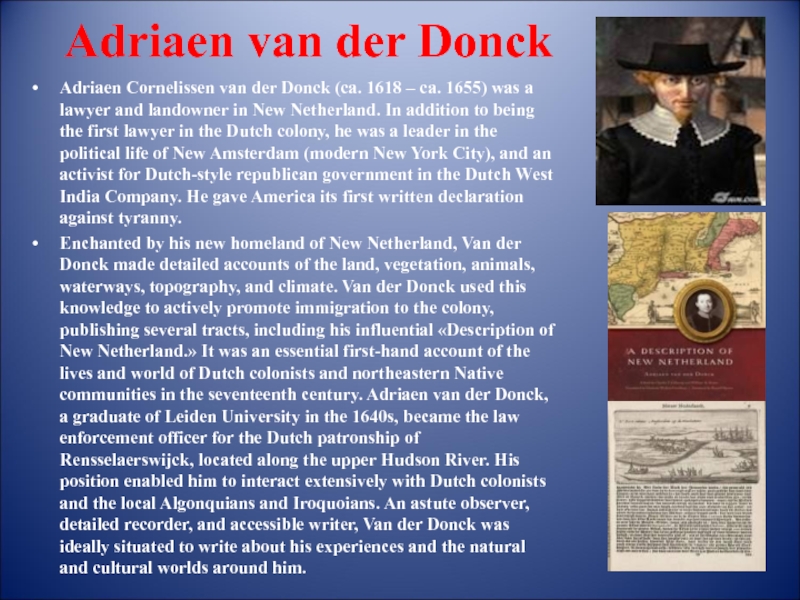
Слайд 28Three American presidents had Dutch ancestry
Martin van Buren, was the
eighth President of the United States. He was a key
organizer of the Democratic Party and the first president who was not of English, Irish, or Scottish descent. He is also the only president not to have spoken English as his first language, but rather grew up speaking Dutch.
Theodore Roosevelt, was the 26th President of the United States. Roosevelt is most famous for his personality; his energy, his vast range of interests and achievements, his model of masculinity, and his “cowboy” persona. In 1901, he became President after the assassination of President William McKinley. Roosevelt was a Progressive reformer who sought to move the Republican Party into the Progressive camp.
Franklin D. Roosevelt, was the 32nd President of the United States. Elected to four terms in office, he served from 1933 to 1945, and is the only U.S. president to have served more than two terms. A central figure of the twentieth century, he has consistently been ranked as one of the three greatest U.S. presidents in scholarly surveys.

Слайд 29Notable Dutch Americans
They are famous all over the world.
In art,
Willem de KooningIn art, Willem de Kooning was a leading
Abstract Expressionist painter.
In literature, Jan-Willem van de WeteringIn literature, Jan-Willem van de Wetering is renowned for his detective fiction.
In entertainment Dutch actress Rebecca Romijn is.best known for her TV-roles on such comedies as Ugly Betty.
In science and technology, Nicolaas BloembergenIn science and technology, Nicolaas Bloembergen won the Nobel PrizeIn science and technology, Nicolaas Bloembergen won the Nobel Prize in 1981 for his work in laser spectroscopy.
In astronomy, Maarten SchmidtIn astronomy, Maarten Schmidt pioneered the research of quasars.
In sports, baseball player and twice World SeriesIn sports, baseball player and twice World Series champion Bert BlylevenIn sports, baseball player and twice World Series champion Bert Blyleven gained fame for his curveball.
In religion, Albertus van RaalteIn religion, Albertus van Raalte was a Reformed Church of AmericaIn religion, Albertus van Raalte was a Reformed Church of America pastor who led the Dutch immigrants who founded the city of Holland, Michigan in 1846.
In Physics, Tomas Alva Edison, one of the most famous scientists of the world.

Слайд 30Stuyvesant's park
In 1836, Peter Gerard Stuyvesant (1778–1847) – the great-great-grandson
of Peter Stuyvesant – and his wife Hellen Rutherford reserved
four acres of the Stuyvesant farm and sold it for a token five dollars to the City of New York as a public park, originally to be called Holland Square, with the proviso that the City of New York build a fence around it. As time passed, however, no fence was constructed, and in 1839, Stuyvesant's family sued the City to cause it to enclose the land. By 1847 the City had begun to improve the park by erecting the magnificent cast-iron fence, which still stands as the second oldest in New York City. In 1850 two fountains completed the landscaping, and the park was formally opened to the public. The public space joined St. John's Square (no longer extant), the recently-formed Washington Square and the private Gramercy Park as residential squares around which it was expected New York's better neighborhoods would be built.
Слайд 31New York City’s oldest public park
Вowling Green is New
York City’s oldest park. According to tradition, this spot served
as the council ground for Native American tribes and was the site of the legendary sale of Manhattan to Peter Minuit in 1626. The Dutch called the area “the Plain” and used it for several purposes. It was the beginning of Heere Staat (High Street, now Broadway)—a trade route which extended north through Manhattan and the Bronx. It was also the site of a parade ground, meeting place, and cattle market. In 1686 the site became public property, when the City Charter put all “waste, vacant, unpatented and unappropriated lands” under municipal domain.
Bowling Green was first designated as a park in 1733, when it was offered for rent at the cost of one peppercorn per year. Lessees John Chambers, Peter Bayard, and Peter Jay were responsible for improving the site with grass, trees, and a wood fence “for the beauty & ornament of the Said Street as well as for the recreation & delight of the Inhabitants of this City.”
By the late 18th century, Bowling Green marked the center of New York’s most fashionable residential area, surrounded by rows of Federal-style townhouses.

Слайд 32Dutch Americans Today
A Dutch American is an inhabitant of
the United States of whole or partial Dutch ancestry.
In
1614 the first Dutch settlers arrived and founded a number of villages and a town called New Amsterdam on the East Coast, which would become the future world metropolis of New York
Between 1820 and 1900, 340,000 Dutch immigrated from the Netherlands came to the United States of America. In the aftermath of World War II, several tens of thousands of Dutch immigrants joined them, mainly moving to California and Washington State. In several counties in Michigan and Iowa, Dutch Americans remain the largest ethnic group.
The Dutch settlers who arrived in the United States in the late 1950s and 1960s were mostly Eurasian refugees of mixed Indonesian and Dutch blood called Indos.
Nowadays, most Dutch Americans, more than 5 million (27%) live in California, followed by New York, Michigan and Pennsylvania.
New Amsterdam Pavilion, a gift from the Netherlands to New York in honour of 400 years of friendship was opened some days ago. The pavilion can be interpreted in different ways and speaks to both the history and the future of the city. But anyway it'll remind people of it's Dutch origin.
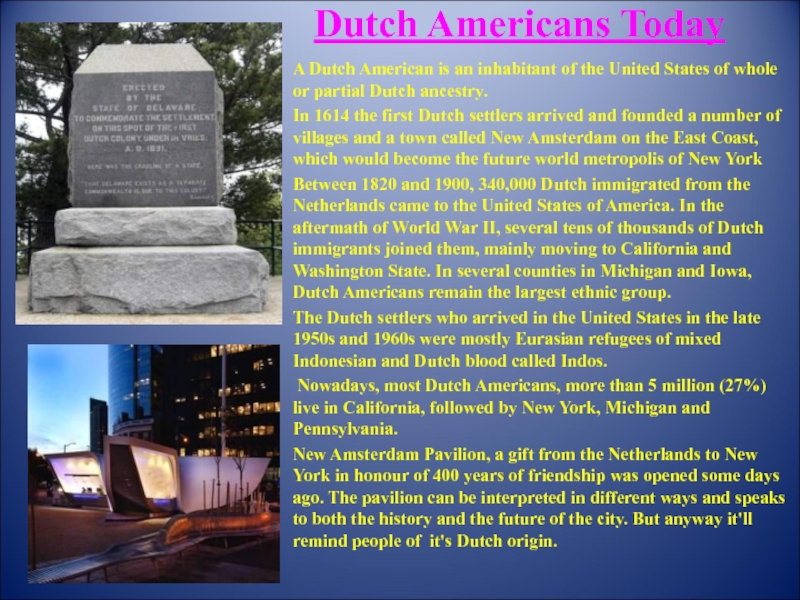
Слайд 33Dutch Colonial Society
Dutch colonial Society appeared in North America in
1962.
Ladies and gentlemen who have attained the age of eighteen
(18) may be eligible for membership in one of the following categories:
Colonial member: Proven direct descent from a Dutch settler born in the Netherlands, and, who immigrated, no later than 19 April 1775, to any settlement in what is now the continental United States.
Also eligible are direct descendants of selected non-Dutch ancestors who settled in what is now the continental United States no later than 19 April 1775, and who have proven significant service to Dutch heritage in business, cultural, military, religious or political affairs either in the Netherlands and/or the United States.
Non-Colonial member: Proven direct descent from any native of the Netherlands who settled in the United States after 19 April 1775.
Membership is by invitation only.
Now they are particularly concentrated around Grand Rapids, Michigan, Sioux City, Iowa, and Des Moines, Iowa. These areas are surrounded with towns and villages that were founded by Dutch settlers in the 19th century, such as Holland, Michigan and Zeeland, Michigan; Pella, Iowa, and Orange City, Iowa. Other Dutch enclaves include Lynden, Washington, Nederland, Texas; and places in New Jersey and California.

Слайд 34The role of the Dutch
The Dutch played an important part
in the development of the United States of America. The
establishment of Dutch settlements in America was a small but nevertheless significant phase of the great European movement for colonization of the New World in the seventeenth century.
The English conquest of 1664 brought Dutch sovereignty to an end, but for over a century afterward Dutch influence continued dominant in local political activity, social life, agricultural pursuits and architectural developments throughout much of New York and northern New Jersey.
The colony of New Netherland made a contribution to colonial religious history when it introduced the Dutch Reformed Church into North America. Established in an age of religious bigotry in Europe, the Dutch colony was a landmark in the struggle for the freedom of religious conscience in the New World.
The Dutch in the Hudson Valley with their pioneer trading posts and later plantation settlements overcame the physical and human hardships of the wilderness and laid the colonial foundation upon which the permanent English settlement of these regions was established in due course.
The penetration of the Dutch into New York and northern New Jersey provided these areas with a fundamental European culture which strongly influenced their subsequent development as English colonies and American states, and of which remains are observable even today.
